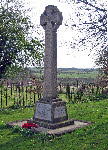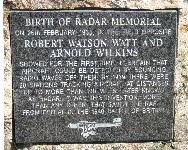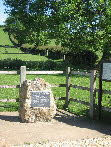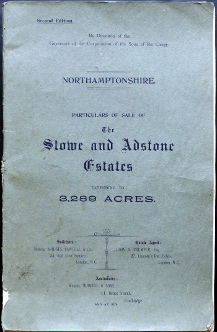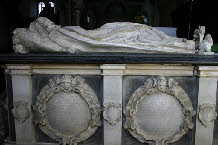History of Stowe Nine Churches
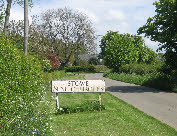
What’s in a name?
Researched by Mike Rumbold
Nine Reasons for Stowe Nine Churches
When I first heard the name Stowe-nine-Churches, like most people I thought, ‘Where did that name come from?’
After hearing several suggestions, I decided to try to find nine alternatives.
I have succeeded, by cheating a little bit. In the following list the first three are really variations of the same story.
- When attempts were being made to build the church, the Devil threw down the work each night. This was repeated eight times, until the builders moved to a different site, whereupon their efforts were successful.
- In an attempt to find out why the work was being destroyed, a Labourer was posted to watch overnight; in the morning he reported that a fierce monster filled in the foundation trenches.
- The site chosen was on a Fairy
Ring and it was the Fairies who were responsible for frustrating the
builders’ efforts.
[It has been suggested that these stories may be a folk memory of the struggle between Paganism and Christianity.] - I have been told that in a document, for which I have no reference, a Priest was referred to as coming from Stowe nigh the Church.
- When the church was newly ‘repaired and beautified’ in 1639, perhaps it was referred to as L’Eglise neuve(feminine); possibly heard incorrectly as L’Eglise neuf(masculine). This may then have been translated into English as Nine Church. Neufalso translates as Nine.
- It is possible that there was a religious settlement here. Some early Christian monastic sites in England included multiple churches. This also occurred in Ireland, where seven was the legendary number. Perhaps this site actually once contained nine small churches or chapels.
- The word Nine is a misunderstanding of the name of the river Nene, pronounced hereabouts ‘Nen’. This flows under Watling Street only about one mile to the North.
- It is possible to see nine other churches from this one. Bridges, the famous historian, when writing about Weedon Bec, says that Whitewell Hill ‘affords a view of twenty spire steeples at once’. Weedon Hill is slightly higher than Stowe.
- Because it is based upon a historic document, I favour the explanation that, as part of the property, the Lord of the Manor of Stowe owned the Advowson, the Right of Presentation, to nine churches.
Upper Stowe has been variously known as Far Stow, Little Stow and Butter Stow.
The following is a quotation from Bridges (1791)
Stowe with the nine Churches ........... is divided into two towns, the one called Church-stowe and Great-Stowe, and the other Little-Stowe, or by the neighbouring villagers, Butter-Stowe, from the circumstance of delivering their butter here every Thursday to the London carrier at a fixed price for the whole year.
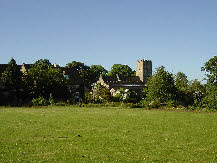
View of The Manor and
St Michael’s Church
Stowe-Nine-Churches boasts a long and varied history
The earliest evidence of settlement at Stowe-Nine-Churches derives from a Prehistoric triple ditch system at the Larches in Church Stowe.
With the villages of Church Stowe and Upper Stowe lying close to the historic Watling Street (A5) and the Whitehall Farm Villa near Nether Heyford which dates from the early 3rd century, the Roman era would have had an influence. The upland position and accessibility of the two villages would also have contributed much to their early history.
The Manor at Church Stowe originally formed part of a Saxon Estate and was recorded in the Doomsday Book (1086). At this point the estates at Stowe are confiscated from their Saxon owner, Tonni of Lusby, and transferred to Gilbert de Ghent, a relative of William the Conqueror. The whole Stowe estate then remains in the ownweship of descendants of Gilbert de Ghent right through to 1715 when it is sold to a charitable organisation, "The Corporation of the Sons of the Clergy". The Sons of the Clergy hold the estate until 1916 when it is broken up and auctioned off as 50 separate lots by Bidwells. The original 1916 auction catalogue can be seen by clicking this link.
It is believed that the present house has its origins in the 15thCentury, the first part being built in 1420.
In the sixteenth century The Manor was owned by John Neville, 3rd Baron Latimer, who was the second husband of Catherine Parr. On his death in 1543, The Manor was given to Catherine for her lifetime. It is said that Henry VIII visited Stowe whilst courting Catherine who later became his sixth wife. Catherine therefore owned The Manor and may have lived there while Queen of England.
The Manor succeeded to the Earl of Danby who added the front part of the house around 1620 for his mother, Lady Elizabeth Carey. The exquisitely carved marble figure of Lady Elizabeth Carey lies to the south side of the altar in St Michael’s, Church Stowe. The work by Nicholas Stone, a leading sculptor of funeral monuments, has been described as one of the finest sculptures of the age for both design and execution. Lady Carey, who died in 1630, is believed to have been a friend of Shakespeare and during an excavation of the crypt it was hoped that some missing manuscripts of Shakespeare might be discovered, but alas not.
Stowe-Nine-Churches contribution to the Great War and World War II.
A total of eight residents of Stowe-Nine-Churches gave their lives in defence of their country in the Great War and World War II.
In addition the village played a more indirect role in World War II. The Rectory, now Wyndham House, was used as a school for Army Padres. Prior to this on 26thFebruary 1935 in a field below Upper Stowe radar was demonstrated for the first time in Britain. Robert Watson Watt and Arnold Wilkins showed that aircraft could be detected by bouncing radio waves off them. It was radar, more than any other invention that saved the RAF from defeat in the 1940 Battle of Britain. A memorial to the Birth of Radar can be seen on the Northampton Road (B4525) near Litchborough.
